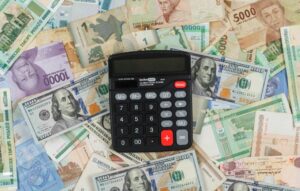The weighted average of a country’s currency in relation to an index or basket of other significant currencies is known as the real effective exchange rate (REER). The relative trade balance of each country’s currency is compared to those of all the other countries in the index to establish the weights.
An increase in a country’s REER is a sign that its imports are getting more affordable while exports are getting more expensive. It is becoming less competitive in the market.
How to Calculate the Real Effective Exchange Rate (REER)?
A country’s currency may be deemed to be undervalued, overvalued, or in equilibrium with the currencies of other countries with whom it conducts commerce. Demand and supply are equal and balanced in an equilibrium condition, which results in stable pricing.
The REER of a nation gauges how successfully that balance is being maintained.
The REER is calculated by averaging the bilateral exchange rates between a country and its trading partners, then weighting the average to account for the relative importance of each trading partner.
REER=CERn×CERn×CERn×100
Where:CER = Country exchange rate
Dissecting the formula:
After determining the weightings for each rate, the average of the exchange rates is determined. For instance, if a currency was weighted at 60%, the exchange rate would be increased by 0.60.
The same is carried out for every currency rate and each weighting. Take the sum of all the currency rates.
The scale or index is then calculated by multiplying the final result by 100. Bilateral exchange rates are used in some calculations, whereas real exchange rates are used in other models. The latter makes the exchange rate inflation-adjusted.
REER is an average that shows when a currency is overvalued in comparison to one trading partner or undervalued in comparison to another partner, regardless of how it is measured.
What Can You Learn From the Real Effective Exchange Rate (REER)?
The REER of a nation is a crucial indicator of its trading prowess.
A country’s currency equilibrium value, the underlying drivers of its trade flow, and the effects of other factors like competition and technological advancements on a country and eventually on the trade-weighted index may all be measured using REER.
For instance, if the value of the dollar declines relative to the euro, exports from the United States to Europe will be less expensive. To purchase American exports, European companies or consumers must first convert their euros to dollars. If the dollar is less valuable than the euro, Europeans can exchange more euros for dollars. As a result, the price of American goods decreases exclusively as a result of the euro’s exchange rate with the dollar.
The United States and Europe engage in significant trade. As a result, the euro to dollar exchange rate would be given more weight in the index. The REER would be more affected by a significant change in the euro exchange rate than by a similar change in the value of another currency with a lesser weighting relative to the dollar.
Real Effective Exchange Rate (REER) Example
Assume that the United States solely engaged in trade with the eurozone, the United Kingdom, and Australia. Thus, the British pound, the Australian dollar, and the euro are all trading partners of the US dollar.
In this fictitious example, the U.S. trades with the eurozone 70% of the time, the United Kingdom 20% of the time, and Australia 10% of the time. The euro would make up 70% of the currency basket in this scenario, followed by the British pound at 20% and the Australian dollar at 20%.
The basket would be more affected by a change in the euro than by a change in the Australian dollar. If the weighted average of the basket didn’t change yet one of the exchange rates changed noticeably, it may indicate that the other currencies moved in the other way, canceling out the movement of the first currency.
REER vs Spot Exchange Rate
The current cost to convert one currency for another for delivery on the earliest feasible value date is known as a spot exchange rate. (The value date is the start of a financial transaction involving a price-variable asset.)
The normal settlement date for the majority of spot transactions is two business days after the transaction date, even if the spot exchange rate is for delivery on the earliest day.
Therefore, the spot exchange rate is a current market price. The REER measures a currency’s worth in respect to its trading partners.
Limitations of the Real Effective Exchange Rate (REER)
Other than commerce, other factors can affect the REER. The real effective exchange rate does not account for price fluctuations, tariffs, or other elements that can have an impact on international trade. If prices differ significantly between two nations, the trade may decline in the nation with the higher prices, affecting its REER.
Therefore, any changes in trade must be reflected in the weighting utilized in the REER computation.
Additionally, each country’s central bank modifies its monetary policy, which can change the home country’s interest rates. As investors seek yield, there may be an increase in the movement of capital to nations with higher rates, which would strengthen the exchange rate.
Please read: TOP DESTINATIONS FOR FOODIES AROUND THE WORLD
Conclusion
For financial authorities like the world bank, BIS, and IMF, who use the metric to comprehend a country’s growth, REER is a crucial term. REER also highlights issues that a particular country is having due to the weak buying power and low value of its currency internationally.
For instance, the IMF calculates REER using the consumer price index. A Consumer Price Index (CPI) tracks changes in a basket of products and services’ prices.





